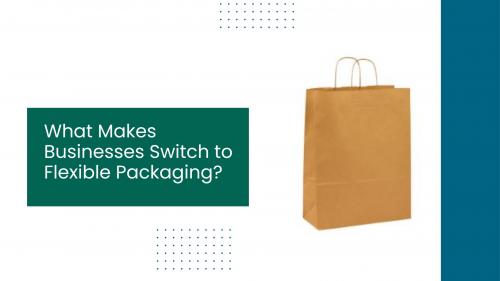What Makes Businesses Switch to Flexible Packaging?

The product packaging design plays a significant role in branding the products. If the design is attractive, it will attract more customers. However, there is also another side of the coin. Nowadays, a large number of organisations are switching from rigid to flexible packaging due to obvious reasons. Flexible packaging materials are eco-friendly, unlike the materials used in rigid packaging. Flexible packs can be personalised easily and manufactured at low costs. Hence, they are the preferred approach in the retail packaging realm.
Top Reasons Businesses are Choosing Flexible Packaging
These days, businesses opt for flexible packaging because of the following reasons:
- Focuses on sustainability and safety: Flexible packaging has an increased sustainable footprint over traditional forms of packaging. Manufacturers use fewer materials while making flexible packing items. Also, flexible packaging comes with a substantial barrier property that protects the packed contents from moisture and oxygen. It keeps the food fresh for a long period.
- More design possibilities: In this competitive landscape, brand marketers opt for flexible packaging due to customisation options. With flexible packing techniques, packaging experts get the scope for 360-degree printing. It enhances the brand image with compelling designs. Also, businesses can explore their packaging strategies and identify out-of-the-box tactics to sell their products.
- Easily recyclable: When it comes to packaging, plastic is the most common material you have heard of. But plastic is harmful to the environment, and for this reason, regulatory bodies of various nations have shunned the use of plastic. This is where flexible packaging gains the upper hand. The materials used in flexible packaging are easily recyclable. The flexible packing products are designed for reuse.
- Low cost: Flexible packaging is an inexpensive solution compared to rigid packaging. As mentioned earlier, the production of flexible packing items requires fewer materials. This packaging approach also guarantees a higher product-to-package ratio, thereby minimising manufacturing costs. Apart from these, flexible packaging products are lightweight and ensure low shipping costs. This lightweight property of flexible packing materials consumes less space in storage.
Wrapping Up
As you can understand, several reasons instigate businesses to opt for flexible packing designs. This trend is predominant in the retail packaging sector. When the factors mentioned above come together, the operational costs of organisations get reduced by a significant margin. It also maximises their Return On Investment (ROI) in the long run. In recent times, flexible packaging has become a win-win situation for brands, consumers, and the planet.
Advertise on APSense
This advertising space is available.
Post Your Ad Here
Post Your Ad Here
Comments